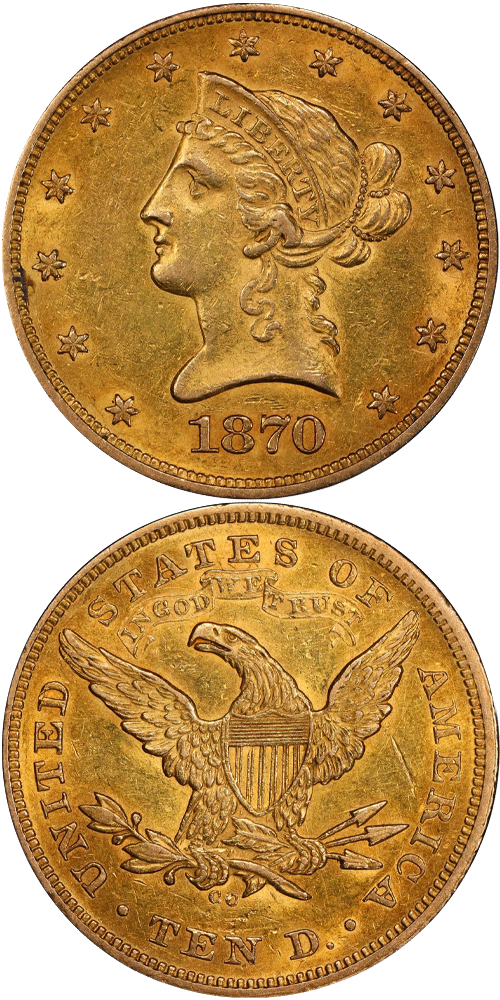1870-CC Liberty Head Eagle
Jeff Ambio: Two die marriages are known for the 1870-CC eagle, both of which share the same obverse. The date on this die is placed somewhat low in the field with the digits slanting down slightly from left to right. The reverse of the Winter 1-B die pairing has a small, round, high set CC mintmark with the first C over the right side of the letter E in TEN and the second C over the left edge of the letter N in TEN. The first C is noticeably higher than the second.The 1870-CC eagle is the most consistently well struck of the three first-year gold issues from the Carson City Mint. Even so, this is an extremely challenging issue to obtain with sharp definition and strong eye appeal. The small number of coins that have survived (Rusty Goe, 2003, accounts for only 70-80 coins extant from a mintage of 5,908 pieces) are mostly well worn and grade no finer than VF. What's more, even in lower grades this issue is apt to display numerous deep, detracting abrasions on both sides.
Rusty Goe: About 3,700 people lived in Carson City in 1870. In January about 30 of them reported for duty at the newly opened mint. No one in the small northwestern Nevada village, except possibly Superintendent Abraham "Colonel" Curry, had read the words Philadelphia Mint Director James Pollock had written in 1864 to stress the significance to a nation of having a coining operation. "Coinage is one of the highest and most important attributes of national sovereignty," said Pollock, "and should be exercised and controlled in such a manner as will tend to strengthen rather than weaken the national Government." Pollock had expressed his solemn sentiments in an attempt to dissuade Congress from establishing a mint in Carson City. To this end he made the following appeal to legislators who, in 1864, were in debate about erecting mints or assay offices in Denver, The Dalles in Oregon, and Carson City: "It is respectfully suggested whether the providing of additional coinage establishments does not tend toward national disintegration."
Government statistics show that Comstock miners had delved $16 million worth of "raw material," in the form of precious metals, from the ground in 1864, the year Congress had debated the viability of establishing a mint in Nevada. By 1870, the output of ore in that region had dwindled to $8.3 million, still a sufficient supply to prime the operations of a start-up mint in the area. First, the officers at that facility would need to persuade the miners to deposit their bullion locally rather than ship it to San Francisco.
However the Mint did not receive the desired response from the mining community. An inability to issue cash (coinage) on receipt of deposits had ensured that the miners would continue to ship the bulk of their bullion to San Francisco. As reported by the Treasury Department, the Carson Mint's share of the Comstock's millions in ore totaled just $266,000 in 1870. Not much, but enough to get started.
Of the gold that had trickled in, the workshop crew minted eagles at first. They delivered 1,644 $10 gold pieces in mid-February, just days after they had struck the first coins ever in Carson City: Liberty Seated silver dollars. The local newspapers didn't have an exact count but excitedly reported that "over $10,000 [in] gold tens were coined in the branch mint" on Monday February 14, with Coiner Ezra Staley scheduled to deliver $5,000 more in face value the next day. For the reporters, who had probably never seen that many gold coins in one place, the mintage figures seemed staggering. They kept their readers informed regularly of all new batches of coins emitted and every bullion deposit.
Staley, and his replacement as coiner in May, Granville Hosmer, would yield 3,448 eagles in the first half of 1870, and Hosmer added another 2,460 pieces between July and December. It was a modest total, but considering the meager gold deposits received, and the fact that neither of the other two working mints had done much in $10 gold piece production in recent years, it gave all concerned a sense of the "important attribute of national sovereignty," that James Pollock had said back in 1864 described the privilege of making coins.
Of the 5,908 1870-CC gold eagles minted perhaps only 80 survive today. This extant population is not much higher than that of its double eagle mate from the same year.
Q. David Bowers: Similar to the other early Carson City Mint coins, the 1870-CC eagle seems to have been distributed primarily in the region in which it was minted. Few if any were exported at or near the time of issue, and any that were shipped overseas in later years were apt to already show extensive signs of wear. I estimate that only 40 or so exist today, challenging the super-famous 1870-CC double eagle in rarity, but it is relatively unheralded. VF is the grade usually seen -- and not very often. At the AU level (EF of a generation ago) the 1870-CC is a prime rarity and is a candidate for finest known.
The example to the left was sold by Stack's Bowers Galleries in the August 2023 Showcase Auction, where it realized $1,080,000.






